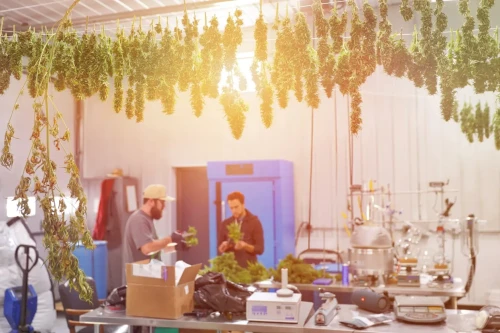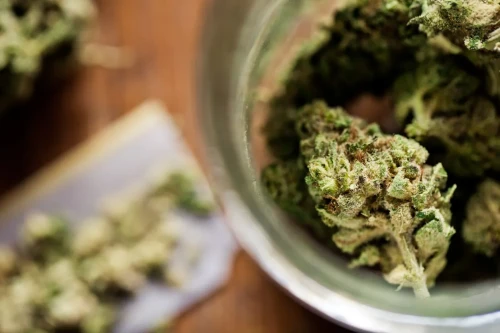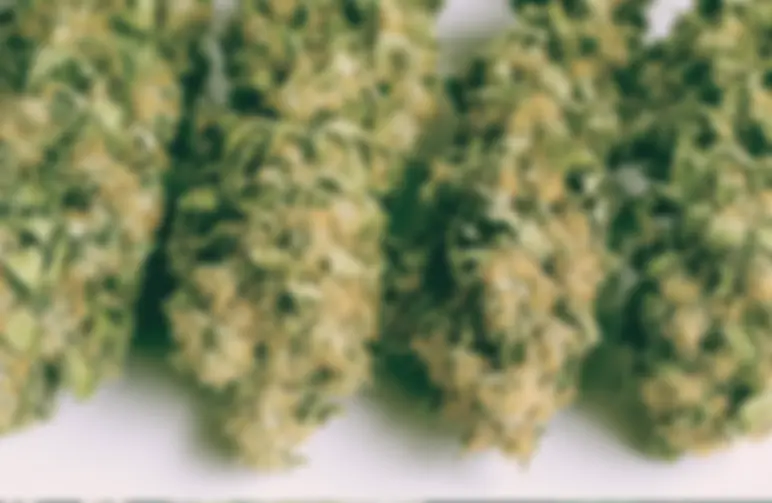The end is almost here, and you can almost taste the cannabis buds. Still, you have some stuff to do to improve the quality.
Once you finish harvesting your weed plants, you can move on to the last two steps. This guide will tell you everything you need to know about drying and curing weed.
Drying Cannabis
As the name suggests, drying weed means you are reducing the amount of water in the harvest. This would do this before moving on to the curing process. The cannabis goes into a separate room to dry for the right amount of time.
If the marijuana buds do not dry long enough, the inside is more likely to be too moist. Additionally, the risk of mould growth may go up when excess moisture is not drained before curing cannabis.
The Importance of Drying Weed
One of the main benefits of drying cannabis is the taste. Dried weed can have a better flavour than a wet harvest.
Another advantage has to do with consumption. When you dry marijuana properly, you can have a smoother smoke.
Not to mention, you do not need to worry about any stickiness. The dry cannabis buds also last longer on the shelf.
Drying weed preparations
You will want to avoid a bad drying process after all the effort you have put in so far. It is necessary to prepare beforehand and use the right method.
To dry weed effectively, you should do these three things:
1. Gather the Materials You Need
One of the tools on the list is the drying rack. A rack contains multiple shelves, and they come in various shapes and sizes.
Some growers prefer to use lines to hang the buds. Another item you will need is a hygrometer.
A hygrometer is a device that allows you to monitor the humidity of the room. Some can measure the temperature as well.
This gadget is essential in making sure you keep optimal conditions for your drying room.
Keep a fan around to circulate the air and prevent moisture from building up. A small fan can get the job done, but you should avoid pointing the device directly at the buds.
This could dry them out faster than intended. You can also use an AC unit or a dehumidifier to combat high humidity.
2. Set up Your Drying Room
Similar to a growing room, you need to create a drying room. A small space makes it easier to control the conditions.
Once you pick an area, make sure it is sanitary to prevent mould and fungi from interfering.
The drying room should be as dark as possible. Light, even ultraviolet light, can affect the quality of your cannabis, degrading the terpenes and cannabinoids.
Maintain the optimal temperature and humidity to ensure a smooth drying period.
Humidity and Temperature
You should keep the humidity anywhere between 40% and 50%. The temperature can be somewhere from 15 to 21 °C (60 to 70°F).
Some people stick to a cooler room to retain much of the cannabinoids and terpenes. Test different temperatures and humidity levels to see which works best for your drying room.
3. Hang Up Your Plants or Use a Drying Rack
A method you can use to dry your marijuana plants is hanging them on a line. Hanging them up can preserve the aroma for longer, and it is a great option for those on a budget.
You would hang the branches upside down, and the flowers need to have enough space between them. They should get exposed to the open, circulated air for the best results.
A drying rack can help you keep your buds organized. Another benefit is that there is a smaller risk of mould or other types of contamination.
How Long Does It Take To Dry Weed?
For hang drying, the average drying time is seven to ten days. The average duration is seven days if you use a drying rack. The amount of time can vary from harvest to harvest.
After your weed is dry, you are not done yet. You will now have to cure your weed, but first, we want to give you a few more tips on the fastest way to dry weed, which is handy in case you are in a big hurry.

How to Dry Weed Fast?
There are several ways you can make the drying process go a little quicker. Still, you do not want to rush it to avoid worsening the quality of the cannabis flowers. The techniques you can use are:
1. Boiler Room Method
You can use the boiler room to help shorten the drying period. The boiler room in your home has a large tank that makes the water warm.
Luckily, the space has reduced relative humidity, and the buds can finish within a few days.
Besides a shorter waiting period, you do not have to worry about the potency getting affected. The boiler room can maintain the temperature on its own.
One of the downsides is that you might have to pay more in utility bills. The quality of the taste could spoil as well.
People with plenty of weed to dry usually hang them up, and some combine this method with the brown bag method.
2. Heater Method
Another technique you can use is placing the trimmed buds near a heater. You can use one that is either electric or gas-powered.
Make sure the area is well-ventilated before you start. The buds still need to be spaced out to prevent mould from ruining them.
The benefit of a heater is that it warms the surrounding air, and the air can hold more evaporated water. The buds can lose moisture efficiently, and the best spot is to place the equipment in the corner.
There is the possibility that the heater may dry too quickly. As a result, the potency could degrade. You might end up with harsh-tasting weed.
3. Oven Method
Alternatively, you can bake your buds dry in the oven. You can place them on an oven tray or cookie sheets.
The oven should be between 50 and 60 °C (125 and 140 °F). In total, the cannabis flowers should bake for ten minutes, but you can flip them after five minutes.
Several growers put cannabis flowers into an oven since the heat starts a process known as decarboxylation. This removes extra CO2 molecules so the THC can form. You get to enjoy the most potency from your yield.
With the oven method, the buds might not taste as good as slowly-dried ones. Also, they will lose potency if you leave them in for too long. Be careful not to make the oven too hot.
4. Microwave Method
Believe it or not, you can dry your harvest in the microwave. First, set the appliance at 30-50% power. Then, turn the microwave on for about 10 to 15 seconds.
Let the buds cool for a minute before flipping them over. You can repeat the process until the buds are dry enough.
Microwaving cannabis is one of the safest drying methods. There is not much risk of damaging the buds as you speed up the drying time. However, it does come with some disadvantages.
One of them is that you do not get to enjoy the full aroma of the buds. Not to mention, the THC levels might not be as high compared to other methods.
5. Sun Method
Some people choose to dry weed under the sun, and the best time to do so is when it is hot outside. You can place the buds in a bag to ensure they dry properly. The benefit of the sun-dry method is that the rays remove the humidity.
After a couple of days, the buds should be dry and ready. Despite the speed, the sunlight likely will ruin the terpenes and can make the cannabis brittle. Not to mention, the cannabinoids get damaged.
6. Freezing Method
Plenty of growers freeze their cannabis to store it. However, you can use freezing as a means to dry your harvest.
The low temperature draws out the moisture as well as turns it into water vapor. Then, the water vapor gets sucked up from the plant by a low-pressure vacuum.
After about a day, the buds should be ready. You can buy a freeze-drying unit or construct one yourself.
One benefit to this method is that the buds keep their integrity and colours. There is minimal terpene and cannabinoid loss during the process.
Buying the freezer can be costly, and the buds are easily breakable. The trichomes may break off if not handled gently.
7. Brown Bags Method
The last method you can try involves brown bags. If the buds are small, you can place them in brown paper bags, with each one containing two or three flowers.
You should open them multiple times a day to help circulate air. You would leave them in a cool place for three to six days.
One advantage is that the bags can trap the aroma, and the taste remains strong. The brown bags also keep the light out to protect the quality of the buds. However, they can trap humidity inside.
The bigger buds tend to take a little longer, and they become more vulnerable to mildew because of the trapped humidity.

Curing Cannabis
Once you finished drying your harvest, it is time to move on to curing cannabis. Not every grower does this last step, but curing can improve the quality of your buds.
Many people want to skip to the good part, but if you choose to cure cannabis, your patience will be rewarded.
What is Curing Weed, and What Does Curing Weed Do?
Curing involves placing the buds inside an airtight jar and waiting. Similar to food preparation, curing weed is all about preserving the flavours and improving the quality of consumption.
The process prevents further loss of the remaining amount of moisture.
Curing weed also stops terpenes from degrading, and you do not have to worry about mould or fungi. An optimal environment means the extra minerals and unwanted sugars get broken down.
How to Cure Weed in the Best Way and Fast?
To cure weed efficiently, follow these three simple steps:
1. Place Buds in Mason Jars
Many growers use glass mason jars to store the cannabis while it cures. The jars should be airtight so nothing can accidentally escape. Not only are they sturdy, but you also can monitor the buds while you wait.
You should place the jars in a dark place to protect the weed from spoiling. The mason jars can fit nicely in a cabinet or box.
After finding the right place to store the buds, keep an eye on the conditions of the space.
2. Provide the Right Temperature and Humidity
Two things you should do is to provide the best temperature and humidity for curing. When it comes to heat, high temperatures can damage the potency of the buds. Not to mention, it holds more humidity in the air.
Likewise, the cold can slow the formation of THC. The best temperature is somewhere between 18 and 21 °C (65 and 70 °F).
You also will need to stop the humidity from becoming too high. However, you still need moisture to maintain the flavour and consistency of the buds.
The right levels of humidity are between 55-65%. You can use a hygrometer to measure the temperature and humidity.
3. Wait and Check
Now, all you have to do is wait for the marijuana to finish curing. Check regularly, especially during the first few days.
You can open the jars to allow the flowers to breathe for a few minutes. You can take the time to measure the interior humidity.
Also, take note of the smell when you open them. A foul odor could mean the presence of bacterial growth. After seven days, you can check the jars every two days.
How Long Does it Take?
Curing should take two to four weeks to complete. Some growers choose to cure for up to eight weeks.
However, a few strains benefit the most from a six-month-long period. Determine how long your harvest needs to reach its potential.
It has been a long journey, and you will find that all of your hard work has paid off. It is time to enjoy your dried and cured cannabis buds.
What have we learned?
The drying and curing process plays an essential part in improving the quality of your harvest.
Drying removes excess moisture to prevent mould and improve taste. Proper conditions, like maintaining proper humidity levels and temperature, are crucial.
Various methods can speed up drying, but each has its trade-offs in terms of quality.
Curing further refines quality by preserving terpenes and breaking down extra minerals and sugars. Mason jars in dark spaces are commonly used for curing, and maintaining humidity levels between 55-65% is key.
Curing can last from two to four weeks or longer for some strains. Overall, these processes ensure a better, smoother, and tastier end product.
sources: https://aresscientific.com/blog/drying-cannabis-flower-guide/, https://www.doctorgreenhouse.com/blog/drying-cannabis-is-there-a-science-behind-the-art





